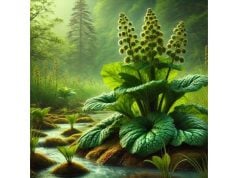
Butterfly Pea (Clitoria ternatea) has become quite the darling of modern herbal and culinary circles, admired for its electric blue flowers and intriguing color-shifting qualities in beverages. Native to tropical regions of Asia, this climbing herb boasts a rich background—from use in traditional Ayurvedic remedies to becoming a trendy ingredient in blue lattes, teas, and cocktails. In many cultures, it’s been cherished not only for its striking hue but also for potential benefits like antioxidant support, hair and skin applications, and mild cognitive enhancement.
What stands out about Butterfly Pea is how easily it can transform drinks with just a few petals, turning water a vivid cobalt or teal. Add an acidic squeeze of lemon or lime, and watch it morph into a purple or pinkish shade—a live chemistry experiment in a glass. Beyond the dazzling color, though, the plant’s unique phytochemicals, including anthocyanins, have generated interest among herbal enthusiasts. From potential memory support to calming properties, Butterfly Pea is finding new fans worldwide.
Below are some of its most frequently noted advantages:
- Packed with anthocyanins that may help protect cells from oxidative stress
- Potential mild cognitive and mood support effects
- Historically used to maintain healthy hair or scalp conditions
- Adds vibrant color to teas, lattes, and desserts without artificial dyes
- Easy to grow in warm, tropical, or subtropical regions as an ornamental or functional herb
Table of Contents
- Butterfly Pea Botanical Profile and Identification
- The Story of Butterfly Pea Through Various Traditions
- Phytochemistry and Active Compounds in Butterfly Pea
- Potential Health Benefits Linked to Butterfly Pea
- Key Properties That Give Butterfly Pea Its Charm
- Typical Butterfly Pea Uses and Safety Considerations
- Significant Studies and Research Findings on Butterfly Pea
- Butterfly Pea FAQ
Butterfly Pea Botanical Profile and Identification
Butterfly Pea (Clitoria ternatea) belongs to the Fabaceae (legume) family, the same large family that includes beans and peas. It’s a perennial vine best recognized for its vibrant, pea-like blossoms that range from deep blue to white, though the blue variety is far more common. Originally from tropical Asia, it’s now grown in warm climates worldwide because of its ornamental value and rising popularity in herbal beverages.
Distinctive Physical Traits
- Leaves and Stems
- Leaves are typically pinnate, comprising pairs of small, elliptical leaflets. The plant’s viney stems allow it to climb or sprawl, latching onto supports with mild twining.
- In some regions, it’s cultivated as a ground cover if not trained on a trellis.
- Flowers
- The showstopper is undoubtedly the blooms: shaped like a typical pea flower but with an intense, sometimes iridescent blue or violet hue. A pale yellow or white marking often appears at the center.
- Certain cultivars produce white flowers, but the blue variety is generally the go-to for culinary or dye applications.
- Pods and Seeds
- Post-bloom, the plant forms slender pods filled with seeds, much like other legumes. These seeds are typically brownish or black when mature, used to propagate new plants if desired.
Preferred Growing Conditions
- Tropical and Subtropical Zones
Butterfly Pea thrives in warm, humid climates with no sustained freezing temperatures. It does best in USDA zones 9–11, though it can be grown as an annual in cooler areas. - Sun and Soil
Full sun is ideal, but partial shade is tolerated. It favors well-draining soils—sandy or loamy—and appreciates moderate watering, especially during its flowering stages.
Variations of Clitoria ternatea
- Single vs. Double-Petaled Blooms
- Some lines of Butterfly Pea produce double petals, appearing more ruffled or fuller than the standard single-petaled type. Both variants hold similar chemical profiles, though the double-petaled ones might be more ornamental.
- White Flowered Varieties
- The white flowered cultivars are visually subtle, lacking the signature blue hue. Nonetheless, they share many of the same phytochemicals, albeit with less intense coloration for culinary dyes.
By focusing on the typical bright blue blossoms and legume-like growth habit, it’s easy to recognize Butterfly Pea if you come across it in a garden or greenhouse. Whether you’re in a tropical climate or just seeing the plant at a botanical display, the luscious flowers are a giveaway that you’re dealing with something both ornamental and potentially beneficial.
The Story of Butterfly Pea Through Various Traditions
Butterfly Pea’s journey merges cultural significance, culinary artistry, and folk medicine roots. Across Southeast Asia, especially in Thailand, Vietnam, and Malaysia, the plant’s vibrant blossoms have long been used for natural coloring or as a mild herbal infusion. The expansion of global cuisine and herbal trade introduced it to Western markets, turning those mesmerizing color-changing teas into a viral phenomenon.
Asian Heritage
- Culinary Staples
- In Thai cooking, Butterfly Pea flowers (often called “dok anchan”) are used to color sticky rice and certain desserts a brilliant shade of blue. The color easily shifts to purple if lemon juice is added.
- Malaysian recipes might incorporate the blossoms in nasi kerabu—a blue-tinted rice dish—thus turning ordinary meals into visually stunning feasts.
- Folk Medicine
- Traditional Ayurvedic and Southeast Asian practitioners mention Butterfly Pea for mild stress relief, memory boost, or supporting healthy hair growth. Pastes made from the petals occasionally appear in local remedies for skin or scalp.
- The intelligence or memory link ties back to shankhapushpi, a term sometimes used in Ayurveda for memory-boosting herbs, among which Butterfly Pea is often included.
Symbolic and Spiritual Notes
- In Cultural Rituals
Some communities incorporate the bright blooms in ceremonies or decorations, symbolizing clarity or the ephemeral nature of beauty. - Regional Folklore
While not as widely mythologized as certain sacred plants, minor superstitions or local tales might mention the bright azure flowers as portending good luck or representing calmness.
Contemporary Emergence
- Global Trend for Blue Tea
- Over the last decade, Butterfly Pea has soared in popularity outside Asia, predominantly for its color-changing tea phenomenon. Instagram-worthy posts of “mood ring tea” sparked a wave of curiosity among Western consumers.
- Mixologists love it in cocktails—like a “mermaid drink”—where the vibrant hue can shift when an acidic or carbonated component is introduced.
- Health-Forward Positioning
- As more people chase functional beverages, marketers have championed Butterfly Pea for possible antioxidant or cognitive perks. This hype parallels how matcha, turmeric, or other exotic ingredients found mainstream acceptance.
- Widespread Availability
- It’s now common to see dried Butterfly Pea flowers or powdered forms sold online or in specialty tea shops, ensuring that folks in cooler, non-tropical regions can experiment with the plant’s color magic.
Through centuries of local uses—both gastronomic and folk-medical—Butterfly Pea eventually transcended its regional roots, capturing global imagination thanks to social media’s thirst for visual novelty. Blending that aesthetic appeal with time-honored uses cements Butterfly Pea as a blossoming star in the cross-cultural herbal sphere.
Phytochemistry and Active Compounds in Butterfly Pea
Butterfly Pea’s standout attribute is its sky-blue to deep-indigo pigments, which revolve around anthocyanins—a class of potent, water-soluble pigments. Beyond color, the plant also houses beneficial peptides and flavonoids that might help explain some of the herbal claims.
1. Anthocyanins: The Color Drivers
- Blue Pigment
The primary anthocyanin in Butterfly Pea is called “ternatin.” Different ternatin derivatives contribute to the range of intense blues and purples. - pH Sensitivity
These anthocyanins shift hue with changes in acidity. As a result, adding lemon or lime to a blue Butterfly Pea infusion can instantly transform it to pinkish or purple, enchanting beverage enthusiasts.
2. Flavonoids and Polyphenols
- Quercetin and Kaempferol
Like many flowers, certain quercetin or kaempferol glycosides appear in Butterfly Pea petals. These can provide mild antioxidant and anti-inflammatory effects. - Possible Vascular Support
By tackling free radicals, flavonoids could help maintain healthy blood flow or skin vitality, though real-world results might be subtle.
3. Peptides: Cyclotides
- Unique Protein Structures
The plant produces interesting ring-shaped peptides known as cyclotides. These are quite stable and have drawn pharmaceutical attention for potential uses in drug delivery or novel therapies. - Antimicrobial Aspects
Some lab tests hint that cyclotides might exhibit mild antimicrobial or insecticidal properties, explaining why the vine is relatively pest-resistant in nature.
4. Additional Components
- Saponins
Trace amounts of saponins may show up, contributing lightly to the plant’s rumored “cleanse” or diuretic roles. However, such effects are overshadowed by anthocyanins in conversation. - Minerals and Vitamins
Butterfly Pea flowers or leaves might hold minimal levels of vitamins (like vitamin C) or minerals, though typically not in high enough amounts to be nutritionally significant.
5. Variation in Parts of the Plant
- Flowers vs. Leaves vs. Roots
- The vivid anthocyanins concentrate heavily in the petals, explaining the color emphasis. Leaves can contain some beneficial phytochemicals, but are less used in mainstream beverages.
- Roots carry certain alkaloids in small amounts. In some traditions, root extracts are used medicinally, but caution is recommended since the root’s chemical makeup is less understood or standardized.
- Fresh vs. Dried
- Drying typically concentrates anthocyanins, but if done improperly, color potency can fade. High-quality dried flowers usually keep a strong azure tone once steeped.
- Powdered forms (sometimes sold as “butterfly pea flower powder”) can deliver a more intense color, albeit the shelf life and flavor might be somewhat altered.
6. Impact on Culinary and Herbal Formulations
- Color and pH
The anthocyanin-laden water can be used as a natural dye in teas, cocktails, pastries, and more. The final shade depends on acidity—ranging from bright blue (basic/neutral) to purple or pink (acidic). - Functional Potential
While the anthocyanin content isn’t as high as in certain berries, consistent consumption might still yield small antioxidant benefits. Many recommend pairing Butterfly Pea infusions with lemon or other vitamin C sources for synergy.
Overall, the anthocyanins (ternatins) hold center stage in describing both the color phenomenon and any antioxidant claims. Coupled with unique peptides and minor flavonoids, Butterfly Pea emerges as an herb that merges botanical allure with mild, beneficial phytochemical properties. Whether you’re drinking it for taste, color, or gentle health support, these compounds underlie its growing global fame.
Potential Health Benefits Linked to Butterfly Pea
Butterfly Pea’s popularity isn’t just about the color spectacle. Multiple cultures have historically leaned on it for a variety of supportive roles, from calming the mind to easing minor tensions. Today, research is gradually backing up some of these claims, though many remain in the preliminary stages. Below are some commonly discussed reasons people incorporate Butterfly Pea into their wellness routines.
1. Relaxation and Mild Cognitive Boost
- Traditional Calming Use
In certain Ayurvedic or Southeast Asian practices, sipping a warm Butterfly Pea infusion was said to help quiet mental chatter or promote gentle relaxation. This may tie into the flavonoid content that modulates stress or enhances mood. - Focus and Memory
Some references associate the herb with improved memory or mental clarity. Studies remain limited, but anecdotal experiences occasionally confirm a mild sense of mental uplift.
2. Antioxidant Support
- Anthocyanins at Work
The bright color indicates anthocyanin presence, which can help combat free radicals. Over time, consistent intake of antioxidant sources might support overall cellular defense. - Skin and Hair
Because antioxidants protect cells, some folks hope that regular Butterfly Pea usage might keep skin youthful or hair shining. Indeed, certain shampoos or hair oils in Asia list the plant as a key ingredient.
3. Mild Digestive and Diuretic Benefits
- Smooth Digestion
Although not as prominent as some strong digestive herbs, mild bitter or astringent notes in the leaves might encourage normal digestion. In certain folk uses, it’s combined with lemon or honey for a gentle “detox” drink. - Fluid Balance
Anecdotal remarks mention subtle diuretic tendencies, but robust scientific data remains sparse. Nonetheless, the pleasant taste can encourage better hydration if you’re substituting it for sugary beverages.
4. Mood-Lifting Color and Aesthetic
- Psychological Appeal
The act of watching your tea switch from blue to purple upon adding lemon can spark genuine joy—a small mental lift. Colors influence mood, so the novelty alone can pep up an afternoon. - Food Presentation
For those who love plating a photogenic meal or presenting guests with something special, the color factor can brighten a culinary event, indirectly boosting enjoyment and positivity.
5. Eye and Vision Myths
- Folklore vs. Reality
Some say the vivid blue color is “good for the eyes,” referencing old cultural traditions linking color-coded foods to bodily organs. While anthocyanins do support vascular health, claims about direct vision improvement are more anecdotal than proven.
6. Gentle Weight Management Aid?
- Calorie-Free Infusion
Swapping a sugary drink for a lightly flavored Butterfly Pea tea can reduce overall calorie intake, potentially assisting weight goals. The vibrant color also distracts from the lack of sweetness. - Metabolic Nudges
A few lab-based mentions propose that anthocyanins might help with lipid metabolism or mild sugar regulation, though these remain in early exploration phases.
Realistic Expectations
- Incremental Support
Butterfly Pea is not a miracle worker. It offers gentle support for relaxation, possible mild antioxidant or cognitive perks, and a pleasing aesthetic dimension. - Lifestyle Factors
Achieving more tangible health improvements usually involves broader changes—consistent hydration, balanced nutrition, stress management, and exercise—rather than relying on any single herb.
From brightening up a routine beverage with aesthetic flair to modestly backing mental clarity or antioxidant goals, Butterfly Pea’s diverse “benefits” revolve around synergy with an overall healthy lifestyle. Sip it for the color, the mild relaxation, or the faint promise of better hair, but keep in mind that it’s best used as a charming accent to your daily regimen, not a sole solution for deeper health issues.
Key Properties That Give Butterfly Pea Its Charm
Beyond its potential health aspects, Butterfly Pea sports characteristics that set it apart from typical garden blooms. From that mesmerizing color shift to its climbing habit and pollinator-friendly blossoms, these defining traits explain why it’s equally beloved by horticulturists, herbal enthusiasts, and adventurous chefs.
1. Mesmerizing Color Transformation
- pH-Responsive
Butterfly Pea’s anthocyanins shift color in response to acidity. At neutral or basic pH, the infusion remains a deep cobalt blue. Add acid—like lemon juice—and it morphs into shades of purple or pinkish red. This property underpins its popularity in “color-changing teas” and flamboyant cocktails. - Edible Dye
Because it’s water-soluble, you can use the infusion to color everything from rice to frosting, making for Instagram-worthy plates.
2. Tropical Vine Growth
- Climbing Habit
In its natural environment, Butterfly Pea attaches to trellises, fences, or other plants, producing a lush curtain of green leaves and bright flowers. If not given support, it can sprawl across the ground. - Versatility in Landscaping
Gardeners appreciate it for covering unsightly walls or for layering among other tropical ornamentals. The ease of care in warm climates also boosts its popularity.
3. Seasonal Blooms
- Year-Round or Extended Flowering
In optimal tropical or subtropical conditions, it can bloom for a prolonged period, giving a near-constant supply of fresh flowers for teas or garnishes. In cooler locales, it’s typically grown as an annual, focusing on a single growing season’s yield.
4. Eco-Friendly Uses
- Nitrogen Fixation
Like other legumes, it can fix atmospheric nitrogen in the soil with the help of symbiotic bacteria in its root nodules. This can slightly improve soil fertility in the surrounding area, a plus for sustainable gardening. - Pollinator Appeal
Bees, butterflies, and hummingbirds may be drawn to the bright flowers, helping maintain local pollinator populations.
5. Mild Aroma and Taste
- Floral Yet Subtle
The raw flowers present a gentle, nearly neutral flavor with faint grassy or earthy notes. Typically, any infusion stands out more for color than taste, so folks often combine the tea with lemongrass, jasmine, or sweeteners for extra flavor. - Absorbs Surrounding Flavors
If you use it in cooking, the blossoms readily pick up other ingredients’ tastes, letting you shape final dishes as sweet or savory as you wish.
6. Culinary Adaptability
- Beverages and Desserts
The most obvious application is steeping the petals in hot or cold water for a vibrant base. But you can also freeze the colored infusion into ice cubes or mix it into dessert batters. - Acidic Interaction
The color shift remains a fun interactive element. A neutral or sweet dish can be tinted blue, while adding tang from yogurt, fruit pulp, or lemon might turn it purple.
7. Minimal Toxicity
- Generally Safe
While any plant can spark allergies in rare individuals, mainstream usage of Butterfly Pea in moderate amounts is widely considered safe. The biggest caution is to confirm you’re getting pure, pesticide-free flowers if you plan to ingest it. - Potential Sides
Very occasional accounts mention mild GI upset if consumed in large volumes, but that’s uncommon. Usually, if the source is reputable and you’re using typical culinary quantities, risk is low.
All in all, the core properties revolve around a brilliant color payoff, an unassuming mild flavor, and a climbing, tropical growth style that suits ornamental settings or farmland. Combined with an easygoing approach to taste infusion, these factors shape the wide range of ways people incorporate Butterfly Pea into beverages, pastry, gardening, or simply ornamental enjoyment.
Typical Butterfly Pea Uses and Safety Considerations
Whether you’re new to Butterfly Pea or eager to expand your current usage, there’s a lot you can explore—culinarily, horticulturally, and in a mild herbal sense. That said, it’s best to keep a few guidelines in mind to fully enjoy what the flower offers while steering clear of potential pitfalls.
1. Culinary and Beverage Applications
- Tea Infusions
- The simplest route: drop a handful of dried or fresh petals into hot water. Within minutes, you get a vivid blue brew. Add lemon or lime for an instant color shift.
- For an iced version, brew it stronger, then pour over ice. Sweeten if desired, or pair with honey, lemongrass, or mint.
- Latte and Milk-Based Drinks
- The powdered form can be whisked into steamed milk or alternative milks (almond, oat, etc.), producing an aesthetically pleasing blue or purple latte.
- Combining with vanilla or a mild sweetener can help accentuate the subtle flavor, turning the drink into a comforting treat.
- Desserts and Baking
- Bakers experiment with incorporating the infused water or powdered petals into cake batters, frostings, mochi, or glutinous rice desserts. This yields bright color, with minimal flavor intrusion.
- If working with acidic dough or batter, expect a purple hue rather than pure blue.
- Savory Twists
- Some creative cooks use it in soups or sauces for that “wow” factor. It can color rice or noodles (like a natural alternative to food coloring).
2. Ornamental Gardening
- Trellis or Fence Coverage
Let the vine climb up a simple support for a living display of large, trifoliate leaves and vibrant flowers. Regular deadheading can encourage more blooms. - Container Growth
In cooler climates, attempt container planting as an annual. Provide a warm, sunny spot or greenhouse-like conditions, mindful that it won’t survive frost outdoors.
3. Mild Herbal Infusions
- Relaxation or Culinary Herb
- While the relaxation angle is subtle, some enjoy a calming evening tea featuring Butterfly Pea along with chamomile or lavender. The color also sets a soothing ambiance.
- Possible Digestive Calm
- A warm mug can help you slow down, rehydrate, and perhaps slightly support digestion if combined with ginger or peppermint.
4. Safety Tips and Warnings
- Allergy Checks
- Although rare, some individuals might be allergic to plants in the Fabaceae family. Start with a small test if you’re uncertain.
- Excessive Consumption
- Typically, large amounts of any herb can cause mild GI disturbance. Enjoy the tea or powder in moderation.
- Pregnancy and Nursing
- Data remain limited. Occasional culinary usage is likely fine, but if you’re considering frequent or heavy consumption, consult a qualified professional.
5. Sourcing High-Quality Petals
- Organic and Chemical-Free
Because the flowers easily absorb external residues, choosing organic or verified pesticide-free sources is a good practice, especially if you’re regularly ingesting the herb. - Fresh vs. Dried
Dried petals are widely sold for teas. If you have the chance to grow or buy fresh blossoms, ensure they’re promptly used or properly dried to prevent mold.
6. Storage and Shelf Life
- Dried Flowers
Keep them in airtight containers, away from moisture and direct sunlight. Typically, you can maintain potent color and mild flavor for up to a year. - Powdered Forms
Powder can clump if exposed to humidity, so store in a sealed jar or bag with a desiccant pack. Don’t freeze, as repeated temperature changes cause condensation.
7. Combining with Other Herbs or Supplements
- Flavor Pairings
Combine with floral or citrusy notes. Lemongrass, for instance, merges well with the earthy undertone, while lemon or lime triggers color changes. - Caution with Stimulants
No major known negative interactions, but if mixing with strong stimulants or other herbal sedatives, keep track of how you feel to avoid unexpected synergy.
All told, the biggest recommendation is to enjoy Butterfly Pea responsibly—whether you’re sipping a bright blue beverage, adding color to a dish, or beautifying your garden. The risk profile is low, so it’s mostly about ensuring you’re getting a trustworthy product and not over-relying on it for any dramatic health claims. Use it for delightful aesthetics, subtle well-being, and a dash of creative sparkle in your daily routine.
Significant Studies and Research Findings on Butterfly Pea
Though still emerging on the global research scene, Butterfly Pea has attracted scientific curiosity for its anthocyanin richness and potential nootropic, antioxidant, or antimicrobial activities. Below are a few highlights from published papers that underscore why this unassuming blue flower keeps piquing interest among scientists.
1. Antioxidant and Anthocyanin Profiling
- High Anthocyanin Concentrations
A 2015 study in the Journal of Food Science measured the anthocyanin content in dried Butterfly Pea petals, confirming robust levels of ternatins. The authors pointed out the plant’s potential as a natural food colorant due to stable color over varied pH ranges. - Scavenging Free Radicals
Multiple in vitro assays, such as one from 2017 in Antioxidants, showed that extracts from the flower can neutralize certain free radicals. While lab-based results don’t guarantee equal in-body action, it’s a stepping stone suggesting beneficial roles.
2. Cognitive and Memory Investigations
- Animal Models
A 2013 trial in Phytomedicine administered Butterfly Pea extracts to rats, noting improved memory retention in certain mazes. The researchers linked these results to possible acetylcholine-boosting effects or neuroprotection from anthocyanins. - Nootropic Potential
Though promising, large-scale human trials remain scarce. The above findings fuel interest in potential mild cognition or memory support, but real-world recommendations are still preliminary.
3. Hair and Skin Applications
- Hair Tonic Studies
Some small local experiments or student projects in Southeast Asia tested topically applied extracts for hair shine or scalp health. Feedback indicated reduced dryness or breakage, but formal peer-reviewed data are minimal. - Skin Formulations
The color and antioxidant properties also appear in cosmetics, with a 2018 Journal of Cosmetic Science piece discussing how anthocyanin extracts might provide gentle skin-protective benefits.
4. Anti-Diabetic and Lipid Modulation Explorations
- Early-Stage Lab Work
A few cell and rodent studies, like a 2020 paper in Nutrition & Metabolism, explored whether anthocyanins in Butterfly Pea could modulate glucose metabolism or cholesterol. They observed modest improvements, suggesting possible synergy with lifestyle factors. - Human Trial Gap
Larger, controlled clinical trials are lacking, so it’s not a recognized therapy for metabolic issues. Still, the preliminary evidence warrants more robust inquiry.
5. Antimicrobial Trials
- Bacterial Growth Inhibition
The Asian Journal of Microbiology in 2019 described how certain extracts from the flowers displayed mild antibacterial activity against some Gram-positive strains. The effect was moderate but showed that the plant has broader beneficial chemical properties. - Food Preservation
A tangential area of research looks at whether Butterfly Pea anthocyanins can serve as a natural additive in foods, extending shelf life or resisting mold. Further testing is needed to confirm feasibility at scale.
6. Color Stability and Food Technology
- Natural Dye Potential
Multiple food technology papers (2016–2021) hail Butterfly Pea anthocyanins as a prospective pH-sensitive natural dye for beverages, candies, or pastries. Ongoing R&D focuses on improving color stability under heat or sunlight.
Butterfly Pea FAQ
Can I grow Butterfly Pea in a cooler climate?
Yes, but it often flourishes best in warm, tropical, or subtropical zones. In cooler climates, treat it as an annual and start seeds indoors before transferring it outside when the weather warms. Ensure it gets enough sun, and remember it won’t survive harsh freezes.
Does Butterfly Pea tea have a strong flavor?
Not particularly. It’s quite mild—often described as slightly earthy or neutral. The main appeal is the stunning color. Many people add lemon, honey, or other herbs to enhance flavor. The color shift from blue to purple when acid is added is part of the fun.
Is Butterfly Pea generally safe to drink every day?
For most people, moderate use of Butterfly Pea tea or color extracts is considered safe. However, as with any herb, it’s wise to avoid excessive intake if you notice any discomfort, and consult a professional if you have specific medical concerns, especially in pregnancy or serious health conditions.
Can it really help with memory or hair growth?
Some rodent studies and folk traditions hint at mild memory or hair benefits. While the plant’s antioxidants and peptides may play a supportive role, you shouldn’t expect dramatic transformations. Combine it with a balanced diet, good scalp care, and healthy lifestyle habits for best results.
Disclaimer
The information in this article is for educational purposes and is not a substitute for professional medical advice. Always talk with a qualified healthcare provider before making major changes to your diet, supplements, or health routines.
If you found this discussion on Butterfly Pea insightful, please consider sharing it on Facebook, X (formerly Twitter), or whichever social platform you prefer. You might spark someone else’s interest in exploring this remarkable blue bloom!










